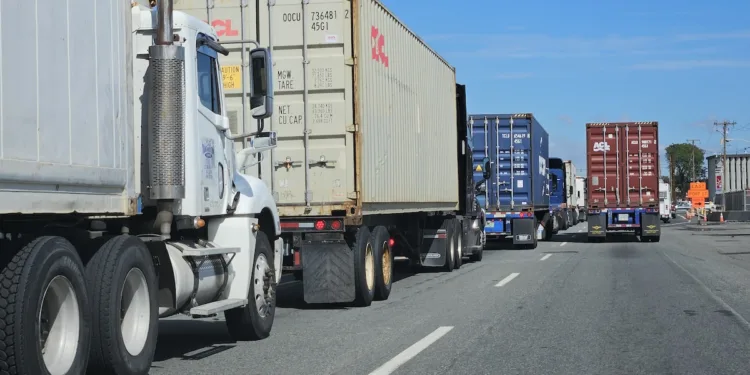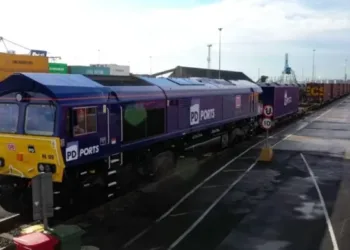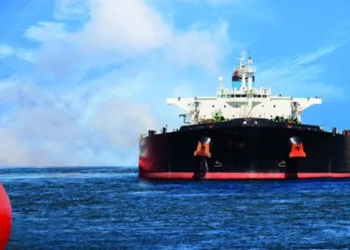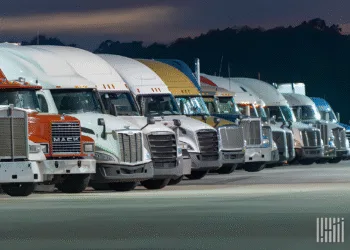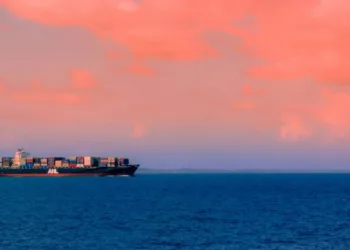Nothing in the supply chain happens in a vacuum.
While lower import volumes give intermodal terminals and railheads a break of sorts, higher fees and regulatory changes are shifting pressure to other parts of the supply chain.
The October forecast from the ITS Logistics US Port/Rail Ramp Freight Index shows a continued downward trend in import volumes, and truckers are expected to feel the pressure.
The weaker international container market “is driving tighter assessment of accessorial fees as ports seek to capture revenue during peak season,” ITS said in a release. “Outside the ports, the evolving regulatory situation surrounding non-domiciled commercial driver licenses is driving lower-cost capacity out of the market, increasing the risk of financial insolvency for some carriers.
These compounding factors are placing a downward squeeze on an already soft drayage market, ITS said, which could cause problems for shippers in both the short and long term.
“Terminals and rail ramps should not face any major challenges due to inbound or export volumes,” said Paul Brashier, ITS vice president of global supply chain. “There are, however, some storm clouds on the horizon that could negatively impact trucking and, by extension, terminal and port operations upstream.”
A federal and state crackdown on non-domiciled CDLs and English-language requirements among drivers begun in September is already causing a surge in bankruptcies across small- and mid-size carriers. Drayage has seen several major providers shutter operations.
The net result, said ITS, will exacerbate financial challenges for many companies in a rate environment negative to operating costs, reducing overall capacity in a process that will eventually affect terminal and port operations.
“In the near term, these new regulations will remove capacity from the ecosystem and cause market disruption,” Brashier said. “In the long term, it could drive many carriers out of business as they struggle to withstand both evolving regulatory pressures and the ongoing freight recession that has pushed rates down to or below operating levels. Vetting service provider health will become even more important as shippers begin late 2025 and early 2026 RFP [request for [contract] proposal] activity.”
The National Retail Federation earlier projected U.S. September import volume at 2.12 million TEUs, down from 2.28 million TEUs in August and a 6.8% year-over-year decline. The trade group expects monthly imports will continue to drop for the remainder of the year on tariffs and first-half frontloading.
“In response to low container demand and declining per-container revenue, ocean carriers are strictly enforcing their accessorial schedules to maintain profitability,” ITS said. “With minimal exceptions beyond clear operational failures, ITS Logistics recommends shippers review their supply chains for any inefficiencies that could be exposed and penalized under this renewed focus.”
Accessorial charges can cover detention, demurrage, customs inspections, chassis usage, storage, pre-pull, and other fees outside standard pickup, transport and delivery. These fees can also range to, say, repairing a damaged twistlock that is preventing a container from being properly secured.
“Shippers should take this opportunity to confirm that accessorial dispute processes and documentation requirements are clearly defined in their SOPs [standard operating procedure],” Brashier said. “If your supply chain utilizes rail for ocean container movement, it’s also important to ensure you understand items like chassis pool flip policies and which parties to engage with to resolve issues within free time.”
Subscribe to FreightWaves’ Rail e-newsletter and get the latest insights on rail freight right in your inbox.
Find more articles by Stuart Chirls here.
Related coverage:
CN and Congebec partner to expand cold chain rail across North America
Rail intermodal, carloads gain for second week in row
Sneaker reseller’s arrest highlights surge in US cargo thefts
Senate confirms Fink to lead Federal Railroad Administration
The post Trucks to feel pressure from weaker port, rail: ITS appeared first on FreightWaves.



